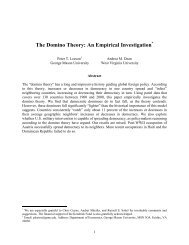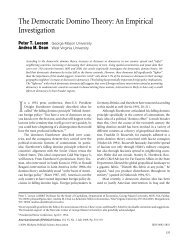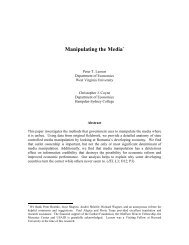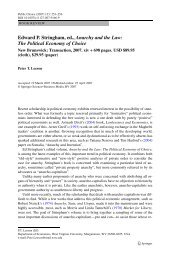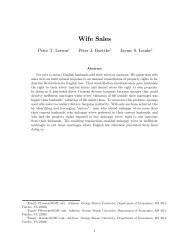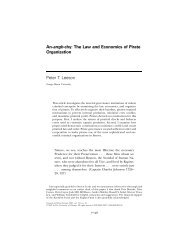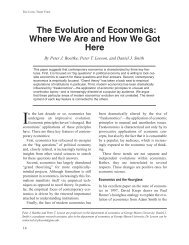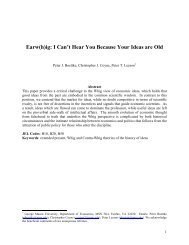Human Sacrifice - Peter Leeson
Human Sacrifice - Peter Leeson
Human Sacrifice - Peter Leeson
You also want an ePaper? Increase the reach of your titles
YUMPU automatically turns print PDFs into web optimized ePapers that Google loves.
had to satisfy Tari’s blood thirst with human sacri…ces just as villages and communities had<br />
to do so to prevent social calamities. As Macpherson described it (C.R. 1846a: 60-61):<br />
The private performance of bloody sacri…ce is deemed necessary, when any<br />
extraordinary calamity marks the anger of the deity towards a particular house,<br />
as, for example, when a child, watching a ‡ock, perishes by a tiger— the form<br />
of which is believed to be assumed by the Earth-goddess for the purposes of<br />
the wrath. On application to the priest, he of course refers the visitation to<br />
the neglected worship of the dread deity, and generally demands an immediate<br />
victim. If this requisition cannot be complied with, a goat is led to the place of<br />
sacri…ce, where its ear is cut o¤ and cast bleeding upon the earth— a pledge that<br />
must be redeemed by human blood, at whatever cost, within the year.<br />
Free riding on others’contributions to meriah purchases exposed the free rider to Tari’s<br />
wrath and, in consequence, misfortune. Fear of such wrath privately incentivized each of<br />
a Kond community’s individual members to contribute “according to his means” to his<br />
community’s meriah purchases.<br />
5. Sacri…ced humans are purchased from outsiders.<br />
Kond communities purchased meriahs from the members of an untouchable caste called<br />
Doms (or Pans). Many Doms lived outside Kond country in the foothills of and the plains<br />
below the Ghats. Other Doms lived inside Kond country, but in separate, itinerant communities<br />
on the outskirts of Kond communities. “Being outcast, they are never allowed to live<br />
within a village, but have their own little hamlet adjoining a village proper”and “frequently<br />
change their place or residence and their protectors”(Fawcett 1901: 34; C.R. 1846a: 47).<br />
The latter Doms had close connections to the former— their families and extended social<br />
groups inhabiting the foothills and plains. “They keep up constant intercourse and connection<br />
by marriage, with the families of their race who live in the low country near the ghauts”<br />
(Selections from the Government of India 1854: 50).<br />
Kond communities used Doms for two purposes: to trade with persons located outside<br />
Kond country and to perform ritually impure acts forbidden to Konds according to their<br />
religion, but permissible to already ritually polluted outcastes such as the Doms. In the<br />
former capacity, Doms operated as middlemen connecting Konds in the hill tracts and non-<br />
Konds in the plains, exchanging Kond produce, such as tumeric, for that of the plains<br />
24



